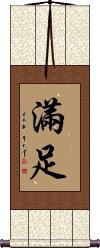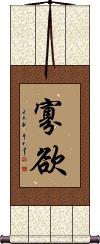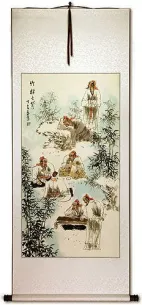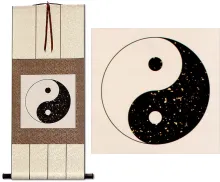Many custom options...
And formats...

Content in Chinese / Japanese...
Buy a Content calligraphy wall scroll here!
Personalize your custom “Content” project by clicking the button next to your favorite “Content” title below...
Content and Motionless
The condition of perfect meditation
安住不動 means at peace and immovable.
The first two Kanji mean being content with one's present position or well-composed.
The last two Kanji mean immobile, firmness, fixed, and/or motionless.
In the Zen school, this is being well-composed and immovable - the ideal state of Zen meditation.
Daodejing / Tao Te Ching - Chapter 33
This is referred to as passage or chapter 33 of the Dao De Jing (often Romanized as “Tao Te Ching”).
These are the words of the philosopher Laozi (Lao Tzu).
To know others is wisdom;
To know oneself is acuity/intelligence.
To conquer others is power,
To conquer oneself is strength.
To know contentment is to have wealth.
To act resolutely is to have purpose.
To stay one's ground is to be enduring.
To die and yet not be forgotten is to be long-lived.
To understand others is to be knowledgeable;
To understand yourself is to be wise.
To conquer others is to have strength;
To conquer yourself is to be strong.
To know when you have enough is to be rich.
To go forward with strength is to have ambition.
To not lose your place is to be long-lasting.
To die but not be forgotten -- that's true long life.
He who is content is rich;
He who acts with persistence has will;
He who does not lose his roots will endure;
He who dies physically but preserves the Dao
will enjoy a long after-life.
Notes:
During our research, the Chinese characters shown here are probably the most accurate to the original text of Laozi. These were taken for the most part from the Mawangdui 1973 and Guodan 1993 manuscripts which pre-date other Daodejing texts by about 1000 years.
Grammar was a little different in Laozi’s time. So you should consider this to be the ancient Chinese version. Some have modernized this passage by adding, removing, or swapping articles and changing the grammar (we felt the oldest and most original version would be more desirable). You may find other versions printed in books or online - sometimes these modern texts are simply used to explain to Chinese people what the original text really means.
This language issue can be compared in English by thinking how the King James (known as the Authorized version in Great Britain) Bible from 1611 was written, and comparing it to modern English. Now imagine that the Daodejing was probably written around 403 BCE (2000 years before the King James Version of the Bible). To a Chinese person, the original Daodejing reads like text that is 3 times more detached compared to Shakespeare’s English is to our modern-day speech.
Extended notes:
While on this Biblical text comparison, it should be noted, that just like the Bible, all the original texts of the Daodejing were lost or destroyed long ago. Just as with the scripture used to create the Bible, various manuscripts exist, many with variations or copyist errors. Just as the earliest New Testament scripture (incomplete) is from 170 years after Christ, the earliest Daodejing manuscript (incomplete) is from 100-200 years after the death of Laozi.
The reason that the originals were lost probably has a lot to do with the first Qin Emperor. Upon taking power and unifying China, he ordered the burning and destruction of all books (scrolls/rolls) except those pertaining to Chinese medicine and a few other subjects. The surviving Daodejing manuscripts were either hidden on purpose or simply forgotten about. Some were not unearthed until as late as 1993.
We compared a lot of research by various archeologists and historians before deciding on this as the most accurate and correct version. But one must allow that it may not be perfect, or the actual and original as from the hand of Laozi himself.
Happiness / Contentment
滿足 is the kind of happiness that involves being satisfied and content.
This can also suggest the actions of “to satisfy,” and “to meet the needs of.”
Other single-word definitions include satisfaction, contentment, sufficient, enough, adequate, full, or complete.
![]() In Japanese, the Kanji for this word is an alternate Chinese form. You can see and select this version at the right (recommended only if your audience is specifically Japanese).
In Japanese, the Kanji for this word is an alternate Chinese form. You can see and select this version at the right (recommended only if your audience is specifically Japanese).
See Also: Satisfaction | Pleasure | Well-Being
Contentment
知足 means content with one's situation or to know contentment (hence happiness).
From the Zen Buddhist context, Chisoku or 知足 (knowing what’s enough) means always to know and be
satisfied with one’s lot.
Human pain and suffering are born of greed, and that greed arises because we do not know what’s enough.
The Chinese philosopher, Menzi (372-289 BCE) said, “to nourish the mind, there is nothing better than to make the desires few.”
This relays the idea that the best method to cultivate the mind is to have little desire.
Live in Peace and Contentment
安居樂業 is the Chinese, Japanese Kanji, and old Korean Hanja proverb for “living in peace and working happily,” or “to live in peace and be content with one's occupation.”
Let It Be / Be Relieved
眉を開く is a Japanese proverb and expression that means “to feel relieved,” “to forget about one's troubles,” or “to settle into peace of mind.”
The literal words suggest relaxing your eyebrows or face. Allow worry or concern to go away, and just be content with “letting it be.”
Note: Because this selection contains some special Japanese Hiragana characters, it should be written by a Japanese calligrapher.
Release of Desires
This in-stock artwork might be what you are looking for, and ships right away...
These search terms might be related to Content:
100 Years of Happy Marriage
Be Happy
Better to Be Happy Than Rich
Comfortable
Don't Worry, Be Happy
Eternal Energy / Eternal Matter
Feel at Ease Anywhere / the World is My Home
Happy
Happy / Laughter / Cheerful Bliss
Happy Birthday
Happy Buddha
Happy Family
Happy Laughter
Happy Marriage
Happy New Year
Mind Over Matter
Optimism / Happy With Your Fate
Please Forgive Me
Serendipity / Happy Coincidence
Not the results for content that you were looking for?
Below are some entries from our dictionary that may match your content search...
| Characters If shown, 2nd row is Simp. Chinese |
Pronunciation Romanization |
Simple Dictionary Definition |
安 see styles |
ān an1 an yasu やす |
More info & calligraphy: Calm / Tranquility(pref,suf) (1) cheap; (prefix) (2) (See 安請け合い) rash; thoughtless; careless; indiscreet; frivolous; (personal name) Yasuji Peace, tranquil, quiet, pacify; to put, place; where ? how? |
三昧 see styles |
sān mèi san1 mei4 san mei sanmai; zanmai さんまい; ざんまい |
More info & calligraphy: Samadhi(1) (さんまい only) {Buddh} samadhi (state of intense concentration achieved through meditation) (san:); (suffix noun) (2) (usu. ざんまい) being immersed in; being absorbed in; indulging in; doing to one's heart's content; (suffix noun) (3) (usu. ざんまい) prone to; apt to; (given name) Sanmai (三昧地) Samādhi, "putting together, composing the mind, intent contemplation, perfect absorption, union of the meditator with the object of meditation." (M. W.) Also 三摩地 (三摩提, 三摩帝, 三摩底). Interpreted by 定 or 正定, the mind fixed and undisturbed; by 正受 correct sensation of the object contemplated; by 調直定 ordering and fixing the mind; by 正心行處 the condition when the motions of the mind are steadied and harmonized with the object; by 息慮凝心 the cessation of distraction and the fixation of the mind; by 等持 the mind held in equilibrium; by 奢摩他, i.e. 止息 to stay the breathing. It is described as concentration of the mind (upon an object). The aim is 解脫, mukti, deliverance from all the trammels of life, the bondage of the passions and reincarnations. It may pass from abstraction to ecstasy, or rapture, or trance. Dhyāna 定 represents a simpler form of contemplation; samāpatti 三摩鉢底 a stage further advanced; and samādhi the highest stage of the Buddhist equivalent for Yoga, though Yoga is considered by some as a Buddhist development differing from samādhi. The 翻譯名義 says: 思專 when the mind has been concentrated, then 志一不分 the will is undivided; when 想寂 active thought has been put to rest, then 氣虛神朗 the material becomes etherealized and the spirit liberated, on which 智 knowledge, or the power to know, has free course, and there is no mystery into which it cannot probe. Cf. 智度論 5, 20, 23, 28; 止觀 2; 大乘義章 2, 9, 1 3, 20, etc. There are numerous kinds and degrees of samādhi. |
知足 see styles |
zhī zú zhi1 zu2 chih tsu tomotaru ともたる |
More info & calligraphy: Contentment(personal name) Tomotaru Complete knowledge; satisfaction. |
安貧樂道 安贫乐道 see styles |
ān pín lè dào an1 pin2 le4 dao4 an p`in le tao an pin le tao |
More info & calligraphy: Better to be Happy than Rich |
分 see styles |
fèn fen4 fen bun ぶん |
part; share; ingredient; component (n,n-suf) (1) part; portion; share; (suffix noun) (2) amount; worth (as in "two days' worth"); enough (for); (3) one's means; one's place; one's lot; one's social position; (4) one's duty; one's part; (5) condition; state (of affairs); extent; rate (as in "at this rate"); (n,adv) (6) in proportion to; just as much as; to the same degree; (suffix noun) (7) content (e.g. alcohol); percentage; (suffix noun) (8) (See 兄貴分・2) equivalent to (e.g. an old brother); (surname) Wake To divide. separate; a fractional part: a share: a duty. |
嗛 see styles |
qiàn qian4 ch`ien chien |
pouch; hold; content |
埴 see styles |
zhí zhi2 chih hani はに |
soil with large clay content (surname) Hani |
媅 see styles |
dān dan1 tan |
content; happy |
実 see styles |
shí shi2 shih jitsu(p); jichi じつ(P); じち |
Japanese variant of 實|实 (noun - becomes adjective with の) (1) truth; reality; (noun - becomes adjective with の) (2) (じつ only) sincerity; honesty; fidelity; (noun - becomes adjective with の) (3) (じつ only) content; substance; (noun - becomes adjective with の) (4) (じつ only) (good) result; (m,f) Minoru |
度 see styles |
duó duo2 to do ど |
to estimate; Taiwan pr. [duo4] (n,n-suf) (1) degree (angle, temperature, scale, etc.); (counter) (2) counter for occurrences; (n,n-suf) (3) strength (of glasses); glasses prescription; (n,n-suf) (4) alcohol content (percentage); alcohol by volume; (5) (See 度を過ごす) extent; degree; limit; (6) (See 度を失う) presence of mind; composure; (given name) Wataru pāramitā, 波羅蜜; intp. by 渡 to ferry over; to save. The mortal life of reincarnations is the sea; nirvana is the other shore; v. pāramitā, 波. Also, to leave the world as a monk or nun, such is a 度得 or 度者. |
憺 see styles |
dàn dan4 tan tan |
peace Tranquil, content. |
數 数 see styles |
shuò shuo4 shuo kazusaki かずさき |
(literary) frequently; repeatedly (surname) Kazusaki To number, count, enumerate, figure out, calculate, reason, reprimand; numbers, an account, fate, destiny; flurried. It is also used for 智 knowledge, and for mental content or conditions as in 心數. |
肉 see styles |
ròu rou4 jou niku にく |
meat; flesh; pulp (of a fruit); (coll.) (of a fruit) squashy; (of a person) flabby; irresolute; Kangxi radical 130 (1) flesh; (2) meat; (3) flesh (of a fruit); pulp; (4) the physical body (as opposed to the spirit); flesh; (5) thickness; (6) content; substance; flesh; (7) (See 印肉) ink pad māṃsa. Flesh. |
醇 see styles |
chún chun2 ch`un chun jun じゅん |
alcohol; wine with high alcohol content; rich; pure; good wine; sterols (1) (obsolete) pure sake; full-bodied sake; (adjectival noun) (2) (obsolete) pure; (given name) Jun |
三性 see styles |
sān xìng san1 xing4 san hsing sanshō |
The three types of character 善, 惡, 無記 good, bad and undefinable, or neutral; v. 唯識論 5. Also, 徧依圓三性 the three aspects of the nature of a thing— partial, as when a rope is mistaken for a snake; only partly reliable, i.e. incomplete inference, as when it is considered as mere hemp; all around, or perfect, when content, form, etc., are all considered. |
事由 see styles |
shì yóu shi4 you2 shih yu jiyuu / jiyu じゆう |
main content; matter; work; origin of an incident; cause; purpose; subject (of business letter) reason; cause |
五時 五时 see styles |
wǔ shí wu3 shi2 wu shih goji |
(五時教) The five periods or divisions of Śākyamuni's teaching. According to Tiantai they are (1) 華嚴時 the Avataṃsaka or first period in three divisions each of seven days, after his enlightenment, when he preached the content, of this sutra; (2) 鹿苑時 the twelve years of his preaching the Āgamas 阿含 in the Deer Park; (3) 方等時 the eight years of preaching Mahāyāna-cum-Hīnayāna doctrines, the vaipulya period; (4) 般若時 the twenty-two years of his preaching the prajñā or wisdom sutras; (5) 法華涅槃時 the eight years of his preaching the Lotus Sutra and, in a day and a night, the Nirvana Sutra. According to the Nirvana School (now part of the Tiantai) they are (1) 三乘別教 the period when the differentiated teaching began and the distinction of the three vehicles, as represented by the 四諦 Four Noble Truths for śrāvakas, the 十二因緣 Twelve Nidānas for pratyekabuddhas, and the 六度 Six Pāramitās for bodhisattvas; (2) 三乘通教 the teaching common to all three vehicles, as seen in the 般若經; (3) 抑揚教 the teaching of the 維摩經, the 思益梵天所問經, and other sutras olling the bodhisattva teaching at the expense of that for śrāvakas; (4) 同歸教 the common objective teaching calling all three vehicles, through the Lotus, to union in the one vehicle; (5) 常住教 the teaehmg of eternal life i. e. the revelation through the Nirvana sutra of the eternity of Buddhahood; these five are also called 有相; 無相; 抑揚; 曾三歸—; and 圓常. According to 劉虬 Liu Chiu of the 晉 Chin dynasty, the teaching is divided into 頓 immediate and 漸 gradual attainment, the latter having five divisions called 五時教 similar to those of the Tiantai group. According to 法寶 Fabao of the Tang dynasty the five are (1) 小乘; (2) 般着 or 大乘; (3) 深密 or 三乘; (4) 法華 or 一乘; (5) 涅槃 or 佛性教. |
休載 see styles |
kyuusai / kyusai きゅうさい |
(noun, transitive verb) suspending publication (of serialized content in newspapers, magazines, etc.) |
低い see styles |
hikui ひくい |
(adjective) (1) (ant: 高い・1) low (rank, degree, value, content, quality, etc.); (adjective) (2) low (position); close to the ground; (adjective) (3) short (height); (adjective) (4) deep (voice); in a low key; low (volume) |
偏安 see styles |
piān ān pian1 an1 p`ien an pien an |
content to hold a small part of the territory; fig. forced to relinquish the middle ground; forced to move away |
停更 see styles |
tíng gēng ting2 geng1 t`ing keng ting keng |
to stop updating (content) |
催更 see styles |
cuī gēng cui1 geng1 ts`ui keng tsui keng |
(slang) (of a follower) to urge (a blogger etc) to post some fresh content (abbr. for 催促更新[cui1 cu4 geng1 xin1]) |
入り see styles |
iri いり |
(n,n-suf) (1) entering; (2) setting (of the sun); (3) containing; content; audience; (4) income; (5) beginning |
內容 内容 see styles |
nèi róng nei4 rong2 nei jung |
content; substance; details; CL:個|个[ge4],項|项[xiang4] See: 内容 |
內涵 内涵 see styles |
nèi hán nei4 han2 nei han |
meaningful content; implication; (semantics) connotation; inner qualities (of a person) |
八教 see styles |
bā jiào ba1 jiao4 pa chiao hakkyō |
The eight Tiantai classifications of Śākyamuni's teaching, from the Avataṁsaka to the Lotus and Nirvāṇa sūtras, divided into the two sections (1) 化法四教 his four kinds of teaching of the content of the Truth accommodated to the capacity of his disciples; (2) 化儀四教 his four modes of instruction. (1) The four 化法教 are: (a) 三藏教 The Tripiṭaka or Hīnayāna teaching, for śrāvakas and pratyekabuddhas, the bodhisattva doctrine being subordinate; it also included the primitive śūnya doctrine as developed in the Satyasiddhi śāstra. (b) 教通His later "intermediate" teaching which contained Hīnayāna and Mahāyāna doctrine for śrāvaka, pratyekabuddha, and bodhisattva, to which are attributed the doctrines of the Dharmalakṣaṇa or Yogācārya and Mādhyamika schools. (c) 別教 His differentiated , or separated, bodhisattva teaching, definitely Mahāyāna. (d) 圓教 His final, perfect, bodhisattva, universal teaching as preached, e.g. in the Lotus and Nirvāṇa sūtras. (2) The four methods of instruction 化儀 are: (a) 頓教 Direct teaching without reserve of the whole truth, e.g. the 華嚴 sūtra. (b) 漸教 Gradual or graded, e.g. the 阿含, 方等, and 般若 sūtras; all the four 化法 are also included under this heading. (c) 祕密教 Esoteric teaching, only understood by special members of the assembly. (d) 不定教 General or indeterminate teaching, from which each hearer would derive benefit according to his interpretation. |
内容 see styles |
naiyou / naiyo ないよう |
contents; content; substance; matter; detail; import |
加載 加载 see styles |
jiā zài jia1 zai4 chia tsai |
to load (cargo); (computing) to load (content) |
十境 see styles |
shí jìng shi2 jing4 shih ching jikkyō |
Ten objects of or stages in meditation觀 in the Tiantai school, i.e. 陰境 the five skandhas; 煩惱境 life's distresses and delusion; 病患境 sickness, or duḥkha, its cause and cure; 業相境 age-long karmaic influences; 魔事境 Māra affairs, how to overthrow their rule; 禪定境 the conditions of dhyāna and samādhi; 諸見境 various views and doubts that arise; 慢境 pride in progress and the delusion that one has attained nirvāṇa; 二乘境 temptation to be content with the lower nirvāṇa, instead of going on to the greater reward; 菩薩境 bodhisattvahood; see the 止觀 5. |
台割 see styles |
daiwari だいわり |
draft of a magazine's content (usu. a table showing the allocation of each page) |
Click here for more content results from our dictionary
The following table may be helpful for those studying Chinese or Japanese...
| Title | Characters | Romaji (Romanized Japanese) | Various forms of Romanized Chinese | |
| Content and Motionless | 安住不動 安住不动 | an juu fu dou anjuufudou an ju fu do | ||
| Daodejing Tao Te Ching - Chapter 33 | 知人者知也自知者明也勝人者有力也自勝者強也知足者富也強行者有志也不失其所者久也死而不亡者壽也 知人者知也自知者明也胜人者有力也自胜者强也知足者富也强行者有志也不失其所者久也死而不亡者寿也 | zhī rén zhě zhī yě zì zhī zhě míng yě shèng rén zhě yǒu lì yě zì shèng zhě qiáng yě zhī zú zhě fù yě qiáng xíng zhě yǒu zhì yě bù zhī qí suǒ zhě jiǔ yě sǐ ér bù wáng zhě shòu yě zhi1 ren2 zhe3 zhi1 ye3 zi4 zhi1 zhe3 ming2 ye3 sheng4 ren2 zhe3 you3 li4 ye3 zi4 sheng4 zhe3 qiang2 ye3 zhi1 zu2 zhe3 fu4 ye3 qiang2 xing2 zhe3 you3 zhi4 ye3 bu4 zhi1 qi2 suo3 zhe3 jiu3 ye3 si3 er2 bu4 wang2 zhe3 shou4 ye3 zhi ren zhe zhi ye zi zhi zhe ming ye sheng ren zhe you li ye zi sheng zhe qiang ye zhi zu zhe fu ye qiang xing zhe you zhi ye bu zhi qi suo zhe jiu ye si er bu wang zhe shou ye | chih jen che chih yeh tzu chih che ming yeh sheng jen che yu li yeh tzu sheng che ch`iang yeh chih tsu che fu yeh ch`iang hsing che yu chih yeh pu chih ch`i so che chiu yeh ssu erh pu wang che shou yeh chih jen che chih yeh tzu chih che ming yeh sheng jen che yu li yeh tzu sheng che chiang yeh chih tsu che fu yeh chiang hsing che yu chih yeh pu chih chi so che chiu yeh ssu erh pu wang che shou yeh |
|
| Happiness Contentment | 滿足 / 満足 满足 | man zoku / manzoku | mǎn zú / man3 zu2 / man zu / manzu | man tsu / mantsu |
| Contentment | 知足 | chisoku | zhī zú / zhi1 zu2 / zhi zu / zhizu | chih tsu / chihtsu |
| Live in Peace and Contentment | 安居樂業 安居乐业 | an kyo raku gyou ankyorakugyou an kyo raku gyo | ān jū lè yè an1 ju1 le4 ye4 an ju le ye anjuleye | an chü le yeh anchüleyeh |
| Let It Be Be Relieved | 眉を開く | mayu o hira ku mayuohiraku | ||
| Release of Desires | 寡欲 | keyoku | guǎ yù / gua3 yu4 / gua yu / guayu | kua yü / kuayü |
| In some entries above you will see that characters have different versions above and below a line. In these cases, the characters above the line are Traditional Chinese, while the ones below are Simplified Chinese. | ||||
Successful Chinese Character and Japanese Kanji calligraphy searches within the last few hours...













